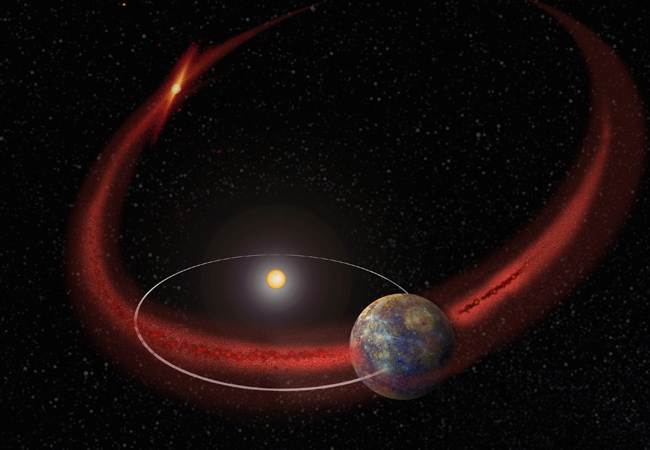
Messenger (MErcury Surface, Space ENvironment, GEochemistry, and Ranging), NASA’s 500 kg Mercury-orbiting spacecraft, has crashed into the closest planet to the sun, ending its historic 11-year mission. Messenger slammed into Mercury’s surface at about 8,750 miles per hour creating a new crater, as wide as 50 feet, on the planet’s surface. The crash wasn’t visible from Earth because it occurred on the far side of Mercury. Before crashing, Messenger undertook extensive mapping of Mercury, and sent over 280,000 splendid images of the planet back to earth.
The probe found that Mercury harbors abundant frozen water and other volatile materials in its permanently shadowed polar craters. In addition, the mission provided many technological firsts, including the development of a vital heat-resistant and highly reflective ceramic cloth sunshade, that isolated the spacecraft’s instruments and electronics from direct solar radiation – vital to mission success given Mercury’s proximity to the sun. The technology will help inform future designs for planetary missions within our solar system.
“The front side of the sunshade routinely experienced temperatures in excess of 300° Celsius (570° Fahrenheit), whereas the majority of components in its shadow routinely operated near room temperature (20°C or 68°F),” said Helene Winters, mission project manager at APL. “This technology to protect the spacecraft’s instruments was a key to mission success during its prime and extended operations.”
Messenger was launched in 2004 and was the first spacecraft to orbit the planet. It traveled about 5 billion miles – a journey that included 15 trips around the sun.
“For the first time in history we now have real knowledge about the planet Mercury that shows it to be a fascinating world as part of our diverse solar system,” said John Grunsfeld, associate administrator for the Science Mission Directorate at NASA headquarters in Washington.
@MESSENGER2011 collides w/ Mercury at ~3:30pm ET. The mission achieved unprecedented success: http://t.co/EKoO8btLtD pic.twitter.com/suuw8buFXj
— NASA (@NASA) April 30, 2015
#thatsmessenger pic.twitter.com/NPK4zqtNPM — MESSENGER (@MESSENGER2011) April 30, 2015
Our @MESSENGER2011 by the numbers. The mission ended today after impacting Mercury’s surface. http://t.co/5F9A5c1E2c pic.twitter.com/S8ujImHk4o
— NASA (@NASA) April 30, 2015
You want to discuss a certain topic with likeminded people or you want to organize a local protest or you have an idea for a project that can help people in need in your local community or all around the world? Join our forum! www.anonboards.com
You want to support Anonymous Independent & Investigative News? Please, follow us on Twitter: Follow @AnonymousNewsHQ












Pretty freaking awesome.
I wonder how The Mars One mission is going? Lmao
temperatures in excess of 300° Celsius (570° Fahrenheit)& (20°C or 68°F) take that logic!!!! you know, for europeans, you americans are weirdo’s in more than one way 🙂
First we bomb the moon men, and now we have struck a blow for democracy against the evil inhabitants of that corrupted solar outpost of the Sun.
Let the Mercurian’s know we Earthlings will crush them!